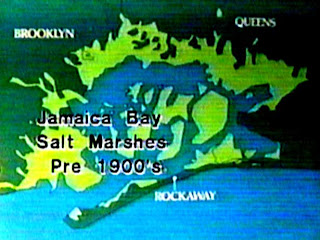 I recently found this report that was prepared by the National Parks Service in 2005 but contains lots of valuable information...
I recently found this report that was prepared by the National Parks Service in 2005 but contains lots of valuable information...“Gateway is a remarkable oasis right in the middle of the hurly burly of big city life, and is a place where anyone looking to get away can find something fun, interesting, and educational to do.
Gateway in the 21st century is going to be the best it's ever been.”
-Congressman Anthony D.Weiner
Introduction - Jamaica Bay has played an important role in the development of New York...
 Once renowned for a robust shellfish industry, Jamaica Bay served as a backdrop for the region’s emerging industrial and residential growth during
Once renowned for a robust shellfish industry, Jamaica Bay served as a backdrop for the region’s emerging industrial and residential growth duringthe 20th century.
Beginning in the 1950’s, the bay adopted the role as a sanctuary from the intensity and alienation of urban life. Today, most visitors and residents value the bay for its diverse recreational opportunities and the chance to reconnect with nature.
But Jamaica Bay continues to change, and the trends are disturbing. Salt marshes one of the bay’s most critical habitats are rapidly disappearing.
Effluent and runoff from industrial and urban development surrounding the bay continue to compromise water quality and have eliminated commercial shellfishing. Other natural and human impacts combine to threaten Jamaica Bay’s health and its continued sustainability as part of a viable ecosystem.
Government agencies with jurisdiction over the bay and entities with vested interests have been studying these changes, amassing considerable data in the process. Over the past few years, bay researchers and users have seen a growing need to share this information and coordinate research and management efforts. As the lead agency charged with managing Jamaica Bay, the National Park Service (NPS) invited other federal, state, and local agencies having a legal or jurisdictional responsibility for activities in the bay, as well as local groups and the public, to come together and share their views on issues.
The information shared, and the interaction gained through public involvement, were preliminary but critical steps in building productive working relationships among the various entities. The agency and public meetings also served to identify complementary programs and activities, as well as potential conflicts. This information will allow agencies and stakeholders to fine tune their activities and maximize benefits to the bay and New York City.
The report that follows summarizes the feedback received in agency workshops, public meetings, and through comment forms. It first discusses the nature and origins of the bay and how this report was developed through public involvement.
It then examines “what was learned” from the feedback received. Finally, the report offers ways to improve how agencies and stakeholders work together to achieve long-term goals for Jamaica Bay.
The NPS hopes the findings presented here will provide a framework for long-term planning for Jamaica Bay, guide short-term actions, and inform future management decisions relating to the bay. By working together, agencies and stakeholders can begin to build a vision for the future of Jamaica Bay.
Read entire report...



























